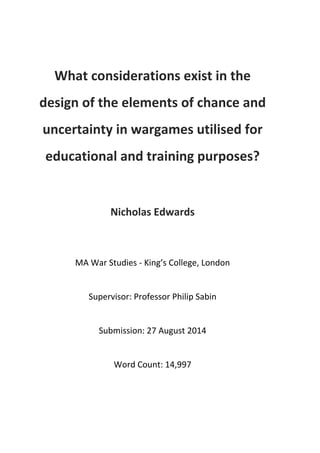
Designing Chance in Wargames
- 2. The author of this report may be contacted via either: nicholas@nced.eu or nicholas.edwards@bisimulations.com
- 3. Nicholas Edwards – MA War Studies – Dissertation 1 DECLARATION: This dissertation is the sole work of the author, and has not been accepted in any previous application for a degree; all quotations and sources of information have been acknowledged. I confirm that my research [x] did or did not [ ] require ethical approval. KCL/13/14-54 - What considerations exist in the design of the element of chance in wargames utilised for training purposes? I am pleased to inform you that full approval for your project has been granted by the WSG Research Ethics Panel. Any specific conditions of approval are laid out at the end of this letter which should be followed in addition to the standard terms and conditions of approval, to be overseen by your Supervisor: o Ethical approval is granted for a period of one year from 21st January 2014. You will not receive a reminder that your approval is about to lapse so it is your responsibility to apply for an extension prior to the project lapsing if you need one (see below for instructions). I confirm that all research records (e.g. interview data and consent records) will be held securely for the required period of time and then destroyed in accordance with College guidelines. (The department will assume responsibility for this if you send your research records to the Senior Programme Officer Panagiotis Stasinopoulos.) [x] Yes Signed: Nicholas Edwards Date: 27 August 2014
- 5. Nicholas Edwards – MA War Studies – Dissertation 3 Contents 1. Introduction ............................................................................................................ 4 2. Chance and Uncertainty as Concepts ....................................................................... 9 2.1 Chance and Uncertainty as Concepts in War ........................................................... 9 2.2 Chance and Uncertainty as Game Mechanics........................................................ 15 3. Developing the Wargame Model ........................................................................... 21 3.1 Developing the Decision‐Making Environment ..................................................... 21 3.2 Explicit Realism and Fidelity ................................................................................... 37 4. Player Reactions to Chance and Uncertainty ......................................................... 46 4.1 Player Reactions to the Model ............................................................................... 46 4.2 Player Reactions to Presentation ........................................................................... 52 5. Conclusion ............................................................................................................. 69 6. Bibliography .......................................................................................................... 74
